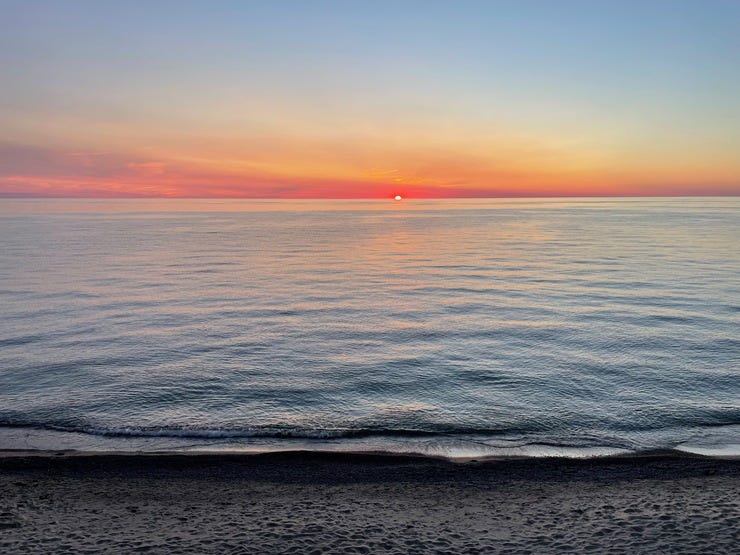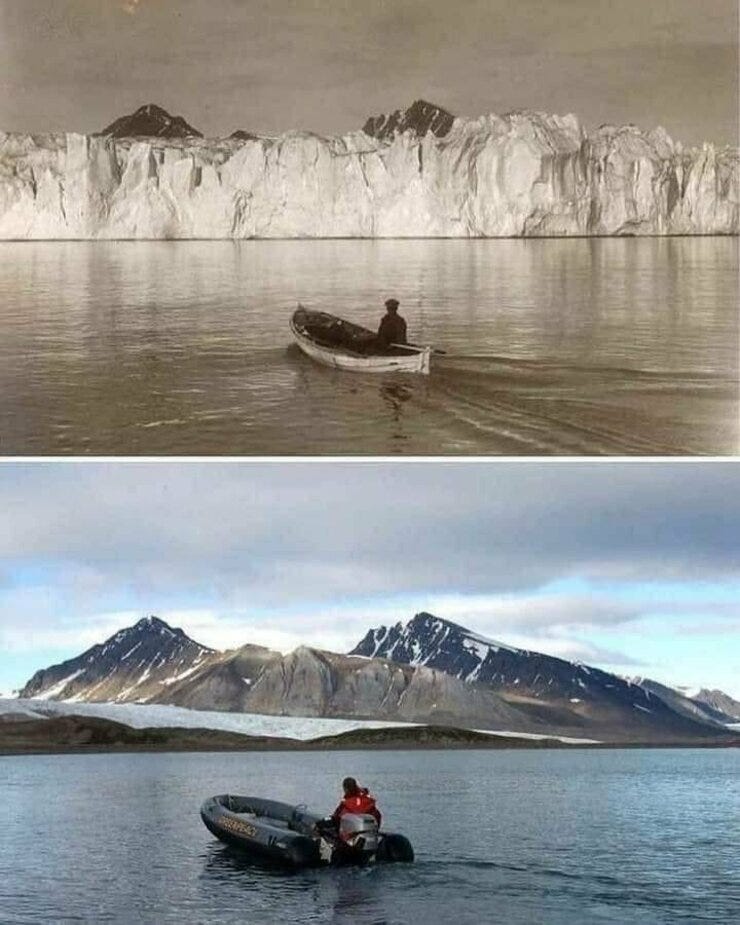Refugia Newsletter #21 by Debra Rienstra: assessing your local climate readiness, ocean plastic clean-up efforts, refugia churches in flood zones, and glaciers then and now
Refugia News
August is the month to revel in Michigan's summer beauties, and I'm pleased to say that I got to enjoy a flawless beach day with family a couple weekends ago. Lake Michigan was warm enough to swim in--one must never take that for granted.
(If you've read Refugia Faith, you know that high lake levels washed out the dune and beach near our family cottage in 2019/2020. I'm pleased to report that lake levels have receded somewhat and we have a little beach again.)
Aside from some glorious time at the lake, I've mostly been laboring away on the Refugia Podcast, editing recordings and prepping for future interviews. This week I'll be interviewing Dr. Stephanie Clinton Boddie, a sociologist working on an oral history project about the Great Migration, and Rev. Dr. Leah Schade, a Lutheran professor of preaching and worship and author of Creation-Crisis Preaching, among other excellent resources for pastors. Look for a launch of Refugia Podcast Season 3 in mid-September.
This Week in Climate News
As I write this on Friday, we are expecting the Inflation Reduction Act to pass the House and become law any minute now. For the most part, environmental activists and analysts are relieved that the bill will pass, and thrilled to have some tangible climate action. The bill and its passing are a huge step in the right direction for US climate policy. Nevertheless, even with $370 billion worth of climate-related goodies, it's not enough. So we're starting to see some analysis of the law's possible impacts: what its provisions could achieve and where they fall short.
One key concern is that the bill doesn't do enough for "frontline communities." Environmental justice folk are pointing out that concessions to the fossil fuel industry in the bill will simply mean more suffering for people in areas where the land, water, and air are already severely polluted by fossil fuel drilling, fracking, and refining. This little article by Kristoffer Tigue in Inside Climate News nicely summarizes the concerns for environmental justice and the plans activists already are cooking up to resist projects the bill could allow. (Much will depend, too, on what happens with the whole "permitting reform" process for which Sen. Joe Manchin wrangled a promise when he agreed to support the bill.)
On the other hand, if people are informed properly and willing to take advantage, there are some great potential benefits for lower-income folk. Stephan Pantano of Rewiring America has done some math and figures that the Inflation Reduction Act could benefit lower-income Americans as much as investing in a regular old IRA. (His analysis on Twitter goes into more detail, actually.)
While federal climate action is crucial, so much can be achieved on the state and local level. So let's have some fun (?) looking at how things are going where you live.
Does your state have a climate action plan? To find out, check out this website created by the Center for Climate and Energy Solutions (formerly the Pew Center on Global Climate Change). If your state has a plan in any stage of development, you can click on your state and find out more. Michigan, I'm glad to say, released our updated plan in April. We can read the whole thing from this link.
Where does your energy come from right now? You can find out at the EPA's Power Profiler website. Enter your zip code, and the site will compare sources of energy for you--gas, coal, solar, nuclear, etc.--to the national profile. Lots of other interesting things to click on and explore. Unfortunately, my zip code right now is heavily dependent on natural gas and, alas, even more coal than the national average. Trying to get all of my household energy from our solar panels, but ... not quite there yet.
What does the climate future hold for your county? Oh this one is super interesting. And scary. ProPublica has created a county-by-county climate futures analysis for the US, based on some deep and wonky projection modeling looking at heat/humidity, wildfires, ocean rise, and crop yields. Will you (or your descendants) need to migrate in the next few decades? Or should you stay put? Counties are listed in order from "yikes, you better run right now" to "you'll probably be more or less OK." Note: those are my phrases.
In the "you better run" category are counties in Louisiana, Texas, Florida, Alabama, South Carolina, Georgia. Fortunately, my county in Michigan (Kent) ranks very low on the horror list. Looks like Vermont is in really good shape, too, in case you're interested in smart real estate investments.
Deeper Dive
For the deeper dive today, we're going to talk about oceans. Are you familiar with the Great Pacific Garbage Patch? It's basically a truly gigantic swirl of floating plastic crap in the middle of the Pacific ocean between California and Hawaii. It covers an area twice the size of Texas. Like you-can-see-it-from-space huge. The GPGP is, unfortunately, the largest of five huge garbage swirls in the world's oceans. The plastic is a combination of fishing industry nets and ropes and things along with tons of plastic that floats into the ocean from polluted rivers. Estimated weight for the GPGP is 80,000 tonnes of plastic waste.
Obviously, this is bad news for marine ecosystems--and for us. The plastics degrade into microplastics and continue to float around in the ocean and back into human systems. In fact, plastic pollution all over our planet is so bad that plastics are now being found in our bloodstreams.
The good news is that a company called The Ocean Cleanup is successfully removing up ocean plastic. The company was founded by a Dutch teenager--no kidding--and just last month announced the success of an initial stage in their larger project:
"Today, our operation in the Pacific Ocean reached an exciting milestone: The Ocean Cleanup has now officially removed more than 100,000 kg of plastic from the Great Pacific Garbage Patch (GPGP)."
How does it work? Well, you can go here to find out. Basically, they use boats and super high-tech floaty boundaries to gather the plastic crap and haul it out of the water. The company is moving on now to a larger scale version of this technique, and they also have processes in the works for catching plastic in rivers before it even hits the ocean.
What happens to the gathered plastic? Well, uh, they're working on that. They hope to recycle it into durable products. They've already sold out their prototype sunglasses.
Refugia Sighting
That national climate futures model site mentioned above predicts dire flooding scenarios for the East Coast of the US, but of course that's happening already, thanks to hurricanes, high tides, and heavy rains. How might churches become places of refugia when their communities experience these dire climate impacts?
A 2020 article in Sojourners by Avery Davis-Lamb (see link below) profiles three remarkable churches who are modeling gospel-inspired responses to crisis situations.
A church in Annapolis, Maryland, has restored marshlands in order to create better flood resiliency for their community. A church in Charleston, South Carolina, after getting pummeled by hurricanes and flooding, has done the work to become experts on flooding impacts in order to influence local flood response strategies. And a church in Aurora, North Carolina, despite most of its members leaving to migrate elsewhere, is still working in their community to convene climate resiliency conversations among local churches.
Davis-Lamb remarks: "What these churches demonstrate is that we do not need a radical revision of the Christian mission during the climate crisis. What we do need is a return to the radical theology of the gospel and its messages of restoration, reclamation, and courage—the courage to radically reimagine the ways we use the gifts of our faith communities to meet the scale of the climate crisis and the imagination to stand shoulder to shoulder with churches across the country, commit ourselves to the common good, and together lay our small bricks of resilience."
Stories of churches reimagining their land, mission, and ministry for the age of climate change.
The Wayback Machine
Rather than an old essay by me this time, let's go back into glacial history. Well, back a hundred years anyway. The two photos below circulated on Twitter this week, so I looked into them a little.
They're real, and part of a series by Swedish photographer Christian Åslund. In 2003, Åslund chose photos from the Norwegian Polar Institute archives and then traveled to the same spots shown in the photos (in the Svalbard archipelago, Norway), at the same time of year, and took new photos in imitation of the old ones. The idea was to provide a striking photographic record of polar ice melt. You can view the whole series here. Keep in mind, these photos show ice melt as of 2003. There was an article about all this in the March 2017 National Geographic (not available online).
Thank you!
Thanks for reading! I keep these newsletters quickly scannable, with opportunities for deeper reading as you are able. I also tend to emphasize the connections between faith communities and climate action.
You can send me a response to this newsletter simply by replying to the email that brought it to you. If you are so inclined, please follow me on Twitter or Facebook @debrakrienstra. You can always contact me on those platforms, too. Also check out my website at debrarienstra.com.
If you like this newsletter, please share with others!





